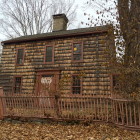Town officials on Wednesday received an application to demolish a Ferris Hill Road home that experts call one of New Canaan’s most historic structures—a development that follows years-long and wide-ranging efforts by its owner and preservationists to save it. The wood-shingled, 1735-built antique home at 8 Ferris Hill Road (or 441 Canoe Hill Road, according to the assessor, same property) sits in the southwestern corner of a 2.14-acre lot, up against the roadway, as is typical of the era. Town resident and builder Max Abel acquired the property in November 2013 for $1,250,000 with the thought of building a second home on the lot. It’s a purchase he said that he now regrets “because I held this naïveté that any plan that I would come up with that would include preserving the old house would be very welcome by all the people of the town, including all the neighbors.”
“And I didn’t see a possibility of anybody objecting to a plan—I could see more demands on how to make a [proposed new] house look more similar [to the antique], or have a garden between [the old and proposed new] houses to connect them, but never envisioned an objection by neighbors.”
The month after he purchased the property, Abel filed an application with the Planning & Zoning Commission for a special permit that would allow the antique home to remain as an accessory structure so that he could build a new house on the property (the combined square footage would go over coverage). Though Abel worked with preservationists and made some concessions in his development plan, several neighbors objected to its specifics, citing safety and aesthetic concerns, and in some cases requesting that P&Z impose requirements regarding the preservation of the antique (thought to have housed Connecticut’s last slave—more on that below), according to P&Z meeting minutes from January and February 2014.



